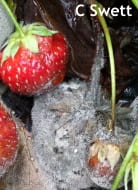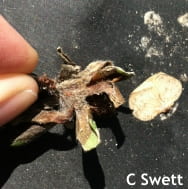Cassandra Swett, Assistant Professor and Extension Specialist – Berry Pathology, University of Maryland and Penn State University; clswett@umd.edu, https://twitter.com/berry_pathology
Strawberries are blooming, the rain is falling and it’s warming into the 60s and 70’—and as a plant pathologist, all I see is Botrytis spores dancing about the farm.
We have already started to see Botrytis popping up on stem tissue and flower petals. Scouting for the pathogen in your fields will help inform you whether you need to spray. Preventing early flower and stem infections is critical to preventing Botrytis fruit rot.
To scout, look for grey fuzzy spores on dead tissue, especially near the base of the crown and on dead flowers under or touching the plastic — the warmer temperatures with the plastic mulch encourage spore formation, even when it’s cool.
Between the rains, fungicides are our main arsenal to protect plants against gray mold, especially during bloom.
A large number of farms in the Mid-Atlantic region are experiencing problems with Botrytis strains (aka, individuals) that are resistant to one or more fungicides. The current status of fungicide resistance in the Mid-Atlantic is shown in the graph below, based on seven Maryland Farms (tests run by Clemson, from March – April 2016).
Some main issues of concern are:
- The increase in strains resistant to BOTH compounds in Switch
- Elevated resistance
- Resistance to boscalid, which has been the more reliable of the two compounds in Pristine (most Botrytis stains are already resistant to the other Pristine product—pyraclostrobin, a strobilurin).
This figure shows the percentage of Botrytis strains (aka, individuals) that are resistant to each fungicide, on each farm. Data courtesy of Dr. Guido Schnabel, Clemson University.
It is important to give these recommendations serious consideration:
- Limit the number of times fungicides in the same class are applied in one year.
- It is recommended that all strobilurin (FRAC group 11, QoI) products not be used for Botrytis control. That’s Abound, Azaka, Cabrio, Pristine, Merivon and Quadris Top. On most farms throughout the east, these products are not effective against Botrytis, and are currently only recommended to control Anthracnose. To control both pathogens, this means that you need to combine a Botrytis-effective compound (like Captevate) with an Anthracnose-effective product (like Cabrio).
- Tank mix broad spectrum fungicides such as captan or Thiram with Topsin M — Topsin M no longer has Botrytis activity (as shown in the graph), but is helpful for several early season foliar diseases.
- Resistance profiles vary from farm to farm. Sample gray mold populations for their resistance through Clemson University. For instructions on how to submit samples see the link below. Contact your local extension agent or extension specialist for assistance in sample submission. http://www.clemson.edu/extension/horticulture/fruit_vegetable/peach/diseases/gm_collectioninstructions.pdf#new
- The current recommendation is to rely on captan and thiram as your main protectants.
ONLY add FRAC 7, 9, 17 or 19 to this base protectant ONLY IF you have high risk situations. High risk occurs when plants remain wet for at least 12 hours, with temperatures above 65°F.
For now, you can estimate risk based on weather monitoring. We are currently working to bring a Botrytis and Anthracnose fruit rot risk evaluation tool to the Mid-Atlantic. This tool, called the Strawberry Advisory System, will provide text and/or email alerts to risk events. An example of a risk monitoring is shown below for the Western Maryland Experiment station, from April 7 to April 28, with a two day forecast from April 29-30. We are currently testing this system in Western Maryland, and plan to expand to grower field trials next year in Maryland, Pennsylvania and Virginia.
SAS-based risk evaluation for Botrytis and Anthracnose fruit rot.
Changes in fungicide efficacy are currently being incorporated into the Mid-Atlantic Berry Guide. For this spring, we recommend that you refer to the Southeast strawberry IPM guide for the most current fungicide resistance management recommendations. Take particular note of changes on pages 8 and 20. http://www.smallfruits.org/SmallFruitsRegGuide/Guides/2016/2016SEStrawberryIPMGuide.pdf
It’s been a bumpy spring for strawberries. At least it sounds like we are out of the frost and freeze events. There’s always a silver lining.





